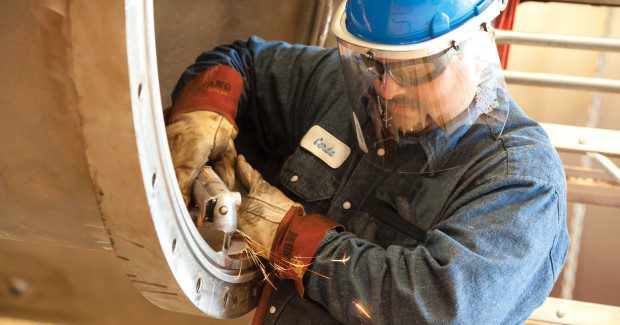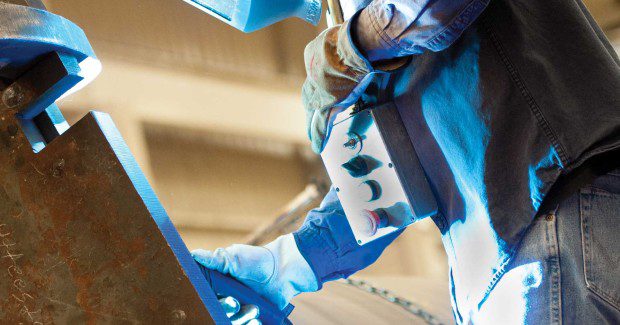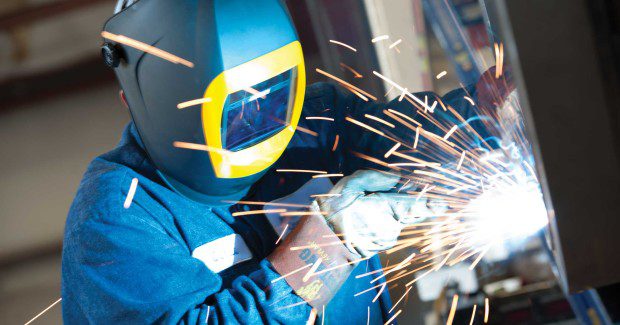Zero Injuries: How Safety and Productivity Find Common Ground
TO meet the ANSI 87.1 regulation for shops regarding PPE compliance around eye, face and head protection, here are some ways on to ensure there is no compromise of workplace safety or productivity in eliminating PPE gaps in safety.
Posted: September 25, 2013
While metal manufacturers can eliminate physical hazards through safety engineering or administrative controls, personal protective equipment (PPE) compliance and safe work behaviors provide welders a last line of defense against eye, face and head injuries. Unfortunately, data shows that many of the welders who sustain these types of injuries were not wearing proper PPE and following safe work practices.
A survey about worksite accidents conducted by the Bureau of Labor Statistics (BLS) revealed that 84 percent of all workers who suffered head injuries were not wearing head protection at the time of the injury even though head protection may have been provided by their employer. The majority of these workers were injured while performing their normal jobs at their usual worksites.
Since it only takes one lapse for an incident to occur, the risk to a company can be high. In fact, 100,000 Americans suffer from serious head injuries on the job each year, with nearly 1,000 American workers experiencing job-related eye injuries each day. Many of these injuries result in permanent disabilities, blindness and even death. The National Council on Compensation Insurance (NCCI) also estimates that a single concussion injury can cost an employer over $143,000 in direct and indirect costs. The average metal manufacturing company would need to sell an additional $2.9M in products to make up this cost.
http://youtu.be/GOISbWe9ZN0
JACKSON SAFETY* G60 Cut Resistant Range is engineered for Automotive and Metal Manufacturing Industries. Providing protection against hand lacerations, cuts and abrasions for key applications, this range offers superior cut resistance, comfortable protection and peace of mind.
Given the various primary and ancillary processes involved in welding (e.g. grinding, torch cutting, etc.), welders are often put in a position where they need to remove their hardhats to don a welding helmet or to add a face shield as they shift between different work tasks. Moreover, in an effort to simplify the inefficiency of switching between hardhats, welding hoods and face shields, metal manufacturers are having to piece together PPE in a way that not only creates safety gaps, but also compliance issues.
Increasingly, high non-compliance with PPE protocols is an alarming trend and a serious threat to worker health and safety. Whether due to economic conditions, a flawed approach to safety programs or ingrained attitudes that result in at risk behaviors, solutions are needed to remove these safety gaps to maintain the health and safety of all workers.
COMPROMISING SAFETY OR PRODUCTIVITY
Safety managers and production managers both face continued challenges when it comes to PPE compliance for the eye, face and head as they make decisions that ensure health and safety are not sacrificed for efficiency and productivity or vice versa. They are left asking, “Do we want to compromise safety or production?”
The compromise for employees is to wear a hardhat at all times unless they are welding, believing that nothing will happen when they are welding, or to be outfitted with a multitude of PPE to protect against all ancillary processes creating excessive inventory.
For example, some manufacturers are issuing employees three different hard hats: one basic hardhat; one hardhat with a face shield attached; and one with a welding helmet attached. While seemingly a logical solution, this creates new challenges with storage, productivity and safety. With up to three different helmets being stored in often confined work zones, workers are finding that they do not have enough space to store helmets properly or to even set them down so as to avoid other hazards. An improperly stored helmet can collect dust and debris. In turn, this debris can shower the employee and penetrate the eyes when stored helmets are donned for a new task, resulting in an injury.
By attempting to ensure worker health and safety through the use of multiple helmets, manufacturers are dealing with cost and production inefficiencies given wasted inventory and wasted motion. This approach is not complimentary to lean manufacturing processes, does not help to reduce waste or lost time, and creates non-compliance issues.
Updated in 2010, the American National Standards Institute (ANSI) and International Safety Equipment Association (ISEA) 87.1 standard outlines the established performance criteria and testing requirements for devices used to protect the eyes, face and head from injuries caused by impact, non-ionizing radiation and chemical exposure in workplaces.
The standard covers all types of protection configurations including goggles, face shields, welding helmets and full face piece respirators. Most notably, the standard requires manufacturers to ensure that if workers are using a combination of PPE together, then that equipment must be tested together to ensure safety compliance. In most cases, this is not occurring.
MOVING TOWARDS STANDARDIZED PPE
Through worker education and training programs around PPE compliance and other face and head injury risk mitigation strategies, safety managers and production managers can collaboratively change imbedded attitudes or behaviors in their workforce that lead to non-compliance and potential injuries. This requires a two-pronged approach that involves employee-focused education and standardized PPE integration, both of which can be implemented in lock-step.
The first approach is for manufacturers to build awareness amongst their employee about the dangers of not using PPE or using non-compliant PPE. In truth, site managers must connect with the hearts and minds of their employees, strengthening each site’s safety culture and building a sense of shared accountability amongst all employees to identify hazards and at risk behaviors before the occurrence of an incident.
To improve productivity, injury reduction and compliance, the second approach is for PPE to be standardized, constant and appropriate for the tasks performed. Eye, face and head protection measures must be consistent and systematic to minimize safety gaps. Safety needs to be prioritized above all else, but that does not have to be at the expense of productivity.
Managers should identify and introduce standardized PPE solutions that will not only mitigate risk but also promote productivity. One such solution is hardhat systems that allow for the quick insertion or release of a welding helmet or face shield, depending on the work task or process involved, without workers ever having to expose their eyes, face or head to danger by removing their hardhat.
These are the types of workplace solutions being derived from Exceptional Workplaces, an initiative of our business through which we help manufacturers create workplaces that are healthier, safer and more productive.














